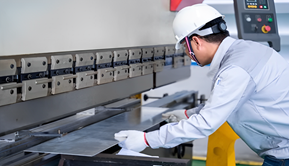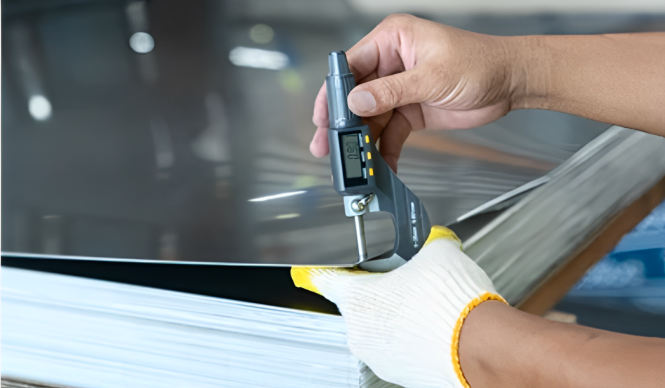Does Galvanized Steel Rust? Everything You Need To Know
Several organizations use galvanized steel for both indoor and outdoor building projects yet rust compromises the product’s longevity. Rust damages steel faster and trigger higher repair expenses. Despite being recognized for its excellent rust protection galvanized steel requires ongoing maintenance to remain corrosion-free. That is the reason many people think, Does galvanized steel rust? The answer lies in the protective mechanism of the zinc coating that is significantly more resistant to rust than untreated steel that can break down through exposure to water and chemicals during extended periods The zinc coating is actually acting as a “protector” that insulate steel from rust for a long time If you don’t know the dangers and protective steps then this guide explains all aspects of galvanized steel, including its rust resistance features and details about corrosion prevention.
Table of Contents
ToggleUnderstanding Galvanized Steel
Galvanized steel is highly resistant to rust due to the zinc coating which makes it widely used in structures and industry. When used on a carbon or mild steel, the zinc forms a durable barrier. But does galvanized steel rust? Not in normal conditions–but long-term exposure may ultimately wear the coating away. Various galvanization processes provide customized durability depending on the environment and the requirements of the products.

| Sr. No. | Property | Typical Range/Value (Galvanized Steel) |
| Chemical Composition (wt%) | ||
| 1 | Silicon (Si) | < 0.04% |
| 2 | Manganese (Mn) | 0.25 – 0.50% |
| 3 | Sulfur (S) | < 0.035% |
| 4 | Phosphorus (P) | < 0.035% |
| 5 | Carbon (C) | < 0.25% |
| 6 | Zinc (Zn) | Variable |
| Mechanical Characteristics | ||
| 1 | Yield Point (MPa) | 200 – 550 MPa |
| 2 | Tensile Strength (MPa) | 300 – 700 MPa |
| 3 | Elongation (%) | 15 – 35% |
| 4 | Coating Adhesion | Good to Excellent |
| 5 | Hardness | Increased surface hardness |
Does Galvanized Steel Rust?
Yes, galvanized steel can rust, but it is much more resistant to rust than regular steel. It is because of the zinc coating. The zinc acts as a barrier that protects the steel from moisture, oxygen, and other main components that cause rust. However, over time, if the zinc layer is damaged or exposed to harsh environments (such as saltwater, acid rain, or industrial pollutants), the steel beneath can eventually rust.
Factors Affecting Rust:
Factors that can cause the rusting of steel are discussed below:
Thin Zinc Coating:
If the zinc coating is thin, it will corrode faster, exposing the steel to rust.
Scratches and Damage:
Scratches or damage to the zinc coating can create entry points for moisture and oxygen.
Corrosive Environments:
Exposure to saltwater, acidic conditions, or high humidity can speed up zinc corrosion.
Galvanization Process
The different protection methods let you select what fits your needs best.
Hot-Dip Galvanization
Steel components enter a bath of molten zinc at the production stage. This process produces a strong protective layer that stays effective for an extended period. The coating works best in open-air settings and manufacturing facilities.

Electro-Galvanization
A thin coating of zinc is applied by the electrochemical process of electro galvanized treatment or electro galvanization. The process also makes a smooth surface that can be used with parts found in cars and electronics.

Galvannealing
Galvannealing is a hybrid process, which consists of galvanizing combined with heat treatment to enhance the surface appearance and corrosion-resistance. It enhances the compatibility of bonding paint and welding tools to coated steel, making it more useful. It is common in the automobile sector and begs the question: Does galvanized steel rust? Although it is very resistant, it can eventually corrode after a long period of harsh treatment.

Mechanical Plating
This method allows the direct attachment of zinc particles to steel without using heat. This process produces a clear and steady coating that works best on small components like screws and metal springs.

Your selection of galvanization depends on the use you plan, how durable you need the steel to be, and what surface finish you want. These methods work together to protect and strengthen steel for improved durability and use.
Why Is Galvanization Important?
A zinc coating protects steel from both rust and environmental harm. Here’s why galvanization matters.
- Extends Steel’s Lifespan: Zinc protective coatings block moisture and oxygen which helps steel stay strong for many years without rust damage.
- Sacrificial Barrier Against Rust: Zinc protects steel from damage by giving up its protective layer before the steel surface. Steel stays protected by its design despite coating damage because zinc protects the surface underneath.
- Cost-Effective and Versatile: Builders use galvanized steel across various industries because it lasts long while staying budget friendly.
- Low Maintenance Requirements: A galvanized steel finish stays durable and resistant to rust with low maintenance that helps you save both time and money.
- Enhances Structural Integrity: Corrosion weakens steel over time. The protective layer of galvanization ensures that steel components retain their structural integrity.
How Galvanization Prevents Rusting
Zinc Coating as a Barrier
The zinc coating acts as a protective layer that blocks moisture, oxygen and chemicals from touching the steel surface. The protective zinc layer helps prevent moisture damage and keeps metal products durable longer.
Sacrificial Protection Mechanism
Zinc corrodes faster than steel because it reacts with environmental elements. In contact with corrosive substances zinc breaks down first to shield the core metal from damage. The metal core stays protected because the steel coating holds up when the outer layer sustains damage.
Self-Healing Properties of Zinc
Over time zinc reacts with carbon dioxide and water to develop zinc carbonate. The top layer covers simple scratches to protect the metal from further decay. Tiny surface cuts will not reach the steel to affect its durability.
Does Galvanized Steel Rust? – Leading Factors
Galvanized steel resists rusting but still shows signs of corrosion with time. Knowing what causes rust enables you to choose effective protection methods.

When the Protective Layer Wears Off
The zinc coating deteriorates from contact with water and chemicals that expose the steel underneath. Physical damage on galvanized steel makes corrosion happen faster.
Chemical Reactions Leading to Corrosion
Zinc reacts with acids salts and industrial contaminates to develop corrosion. White rust builds up as zinc reacts with water while red rust shows up when steel is left unprotected after the zinc layer wears off.
Environmental Factors Affecting Longevity
High humidity speeds up corrosion. Steel galvanized surfaces face faster rusting when exposed to the salt air of coastal regions and industrial zones. Contact with different metals creates galvanic corrosion that leads to early rust formation.
Improper Storage and Handling
Placing galvanized sheets together in wet environments locks in water which speeds up rust formation. A lack of proper airflow allows white rust to form. The right storage methods help steel last longer.
Prolonged Exposure to Extreme Temperatures
Repeated temperature changes create small cracks in the zinc layer making it weaker. The zinc coating on metals fails faster under intense heat and through repeated freezing and thawing.
Signs of Rust on Galvanized Steel
When rust develops on galvanized steel it shows the start of breakdown. Identifying issues at the beginning stage helps you avoid expensive repairs.
White Rust vs. Red Rust
The galvanized steel has a chalky rust which develops in the presence of moisture, an initial stage of zinc corrosion that does not attack the covered steel. Does galvanized steel rust? Yes–as soon as the zinc coating wears through, the oxygen becomes available to the steel and can form red rust, which can damage the steel in the long term. During initial phases using simple remedies white vinegar remove rust and would maintain the structural integrity and increase durability.

Surface Discoloration and Rough Patches
Initial signs show up as steel that looks flat or blotchy plus feels rugged. These initial signs mark the early corrosion process before it grows worse.

Peeling or Flaking Zinc Coating
When the zinc coating loses its bond to the steel underneath rust damage happens. The coating materials fail to adhere properly or last because of extreme environmental conditions.

Localized or Pitting Corrosion Spots
Small pits develop on surfaces that retain excess moisture especially at joints and openings. Damage to steel increases when water builds up over time in these pits.

Structural Weakening and Brittleness
Over time rust problems lead to both structural damage and weak spots. This condition leads to increased danger of failure when steel structures support heavy loads. To find and fix rust issues before they create safety dangers steel pieces must receive regular inspections.

How to Prevent Rust on Galvanized Steel?
Rust prevention is necessary in galvanized steel maintenance. You can take good care of the surface with regular grooming. To have galvanized steel that does not rust, do the following.
Regular Maintenance and Inspection
Check for scratches, wear or early signs of rust. Repair any damage as soon as possible in order to prevent corrosion from spreading. Keep the surface free of dirt and other contaminants which will degrade the zinc layer.
Proper Storage and Handling
Galvanised steel should be kept dry and away from corrosive substances such as acids or salt. Keep away from moisture and store it in a dry place that is well ventilated. Avoid scratching your dog while handling by using protective padding.
Additional Protective Coatings
Paint, powdercoat, or sealant the equipment to provide protection. In addition, they help provide another layer of protection against damage from the environment and moisture.
Using Zinc-Rich Paint for Repairs
Zinc rich paint should be applied to the top of the galvanized coating to make good its protection should the coating be damaged. The open is painted this type of paint to stop rust from forming.
Cathodic Protection
For really extreme conditions they help prevent rust by means of sacrificial anodes. Corroding rather than the steel, they are designed to protect indefinitely in highly corrosive environments.
Comparing Galvanized Steel to Other Corrosion-Resistant Metals
Different metals become available to resist corrosion. Let’s examine galvanized steel properties versus stainless steel together with aluminum and weathering steel.
Galvanized Steel vs. Stainless Steel
The zinc coating on galvanized steel creates a protective layer that provides moderate protection against corrosion. Stainless steel outperforms other metals because its chromium nickel molybdenum alloy creates a strong chromium oxide barrier against corrosion. Even though galvanized steel costs less it fails to match stainless steel’s long-lasting performance in tough conditions especially sea water exposure.
Galvanized Steel vs. Aluminum
Aluminum is lighter than steel and undergoes the formation of an oxide layer that insulates it against the environmental harmful effects. Galvanized steel is heavier but it depends on its coating of zinc to prevent corrosion. The question that always arises is: does galvanized steel rust? It may do so over time should the zinc coating be damaged. Nevertheless, it is a good option in outdoor and construction use.
Weathering Steel (Corten) vs Galvanized Steel in Construction
The weathering steel forms a natural and stable layer of rust to cover itself, thus it is best used in building construction and bridges. Galvanized steel, however, does not corrode at first but are likely to age. Corten weathering steel is more prominent where the rusted look is preferred and strength is required whereas galvanized steel is more suited to standard construction requirements.
| Sr. No. | Feature | Galvanized Steel | Stainless Steel (304/316) | Aluminum (6061-T6) | Weathering Steel (Corten) |
| 1 | Composition | Carbon steel + zinc coating | Fe, Cr, Ni (+Mo in 316) | Al, Mg, Si, Cu | Carbon steel + Cu, Cr, Ni, P |
| 2 | Corrosion Resistance | Sacrificial zinc, moderate | Excellent (Cr oxide) | Excellent (Al oxide) | Protective rust patina |
| 3 | Density | High | High | Low | High |
| 4 | Tensile Strength | Variable, moderate | High | Moderate | Moderate |
| 5 | Yield Strength | Variable, moderate | Moderate | Moderate | Moderate |
| 6 | Cost | Low | High | Moderate | Moderate |
| 7 | Weight | Heavy | Heavy | Light | Heavy |
| 8 | Oxidation | Moderate | Excellent | Excellent | Controlled oxidation(rust) |
| 9 | Use Cases | General outdoor, construction | Food, medical, marine | Aerospace, light structures | Bridges, architectural |
| 10 | Weather Reaction | Zinc degrades over time | Minimal degradation | Minimal degradation | Designed to rust, then stabilize |
Real-World Applications and Lifespan of Galvanized Steel
Real-World Applications and Lifespan of Galvanized Steel
The length of time galvanized steel lasts depends on how it reacts to outdoor conditions.
- Rural Areas. Galvanized steel stays resistant to rust for more than 50 years in clean dry conditions.
- Urban Areas. The chemicals from pollution and vehicle exhaust shorten the steel’s durability to just 25 to 40 years when it faces damaging elements.
- Marine Environments. Corrosion from saltwater and humidity harms galvanized steel structures which normally last 10 to 20 years but maintenance helps lengthen their life.
Common Uses and Their Durability
- Construction, Roofing, and Fencing. Galvanized steel’s strength helps structures last multiple decades in residential and commercial buildings as well as security fences.
- Automotive Applications. It stays strong in vehicle chassis and exterior parts which protects them from rust and helps them last longer.
- Industrial Piping and Outdoor Structures. Factories and bridge structures need galvanized steel because of its powerful design and dependable protection from rust.
- Agricultural Uses. Its strength helps barns silos irrigation systems and fencing stand up to outdoor elements.
- Energy Sector. The energy sector relies on galvanized steel for wind turbine structures and solar panel support frames because this material keeps these systems strong and functional over time.
When to Replace or Re-Galvanize Steel
Periodic examination of steel will enable us to make the right choices towards either repairing or replacing it to maintain its strength. You need to evaluate performance and implement the appropriate protective techniques. Does galvanized steel rust? It is not immune to corrosion, but with time it may damage with poor maintenance. Learning about these risks will enable you to select the most effective protective measures.
Assessing Structural Integrity
Rust only affects a product’s appearance when it stays on the steel surface. Deep corrosion damage affects the structural strength of steel. When rust flakes reveal bare metal parts you must take immediate steps to fix the issue.
Re-Galvanization Options
Steel that has been galvanized can receive another protective coating. Zinc-rich primer thermal spraying and hot-dip galvanization stand out as the most effective rust prevention methods. These processes bring back protection and make steel last longer.
Alternatives to Galvanization for Rust Prevention
Modern finishings provide good defense The application creates a long-lasting barrier using a powder coating gun. Epoxy coating is resistant to chemicals and water. These and galvanization are some of the methods used to prevent steel corrosion without compromising on the environmental and budget demands.
Conclusion
You now have an answer to the question of, Does Galvanized Steel Rust? Although galvanized steel does not rust easily, it can still be damaged over time. Zinc coating may lose its strength with time and begin to rust in the face of environmental factors. To preserve galvanized steel, you should take care of it and use protective layers when storing cathodic corrosion protection or zinc-rich paint can be used to restore the resistance of steel when corrosion has taken place. Evaluation of such protection measures is a guarantee of timeless quality and value of your investment. Galvanized steel functions well and protects rust attacks in various installation conditions with proper maintenance plans.



